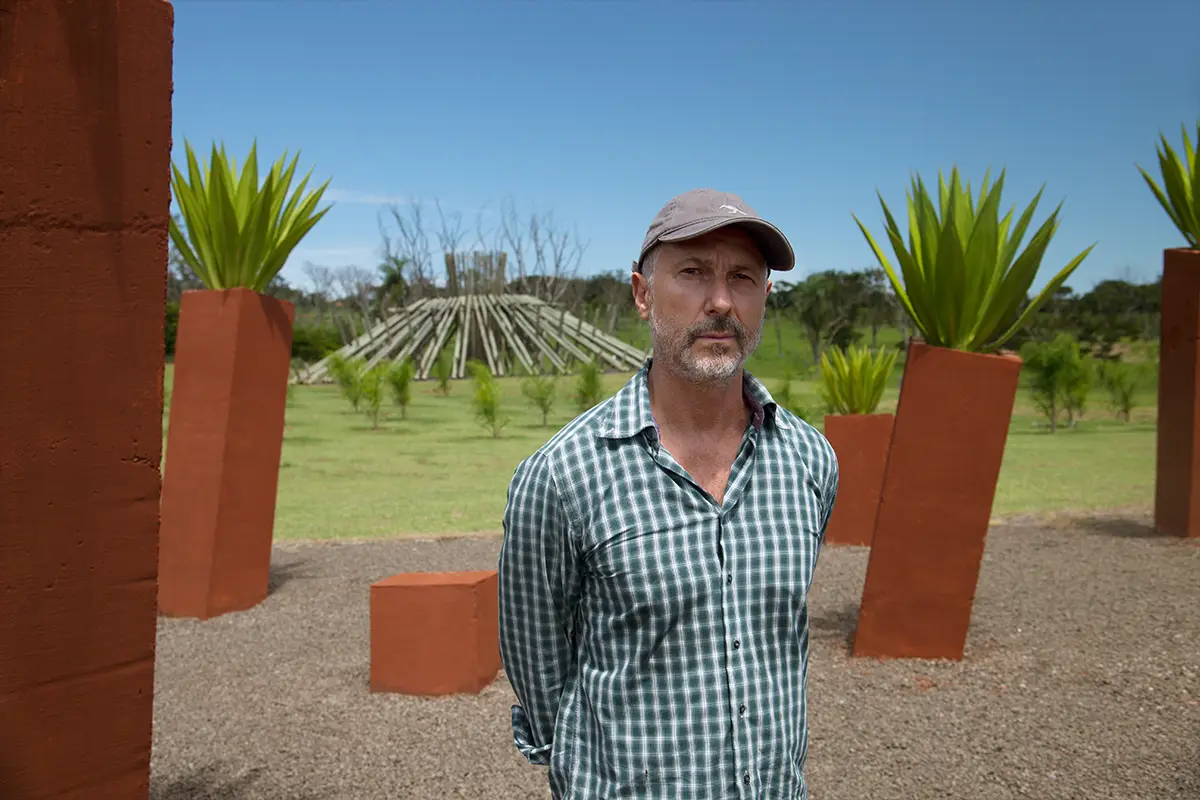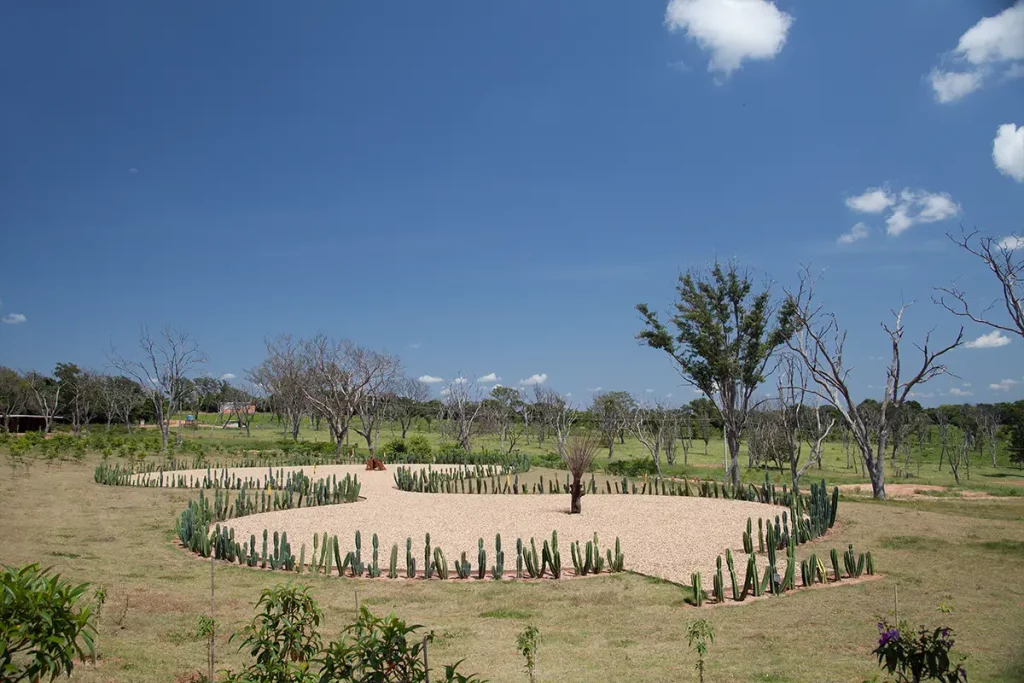Constructing with nature: Humberto Campana’s botanic garden project blossoms as a sanctuary for preserving biodiversity and fostering environmental education
Humberto Campana – Where does the word cultivate come from?
‘Let us cultivate our garden’, replied Candide to Pangloss in the concluding line of Voltaire’s prominent tale ‘Candide, ou l’Optimisme’ (1759). This statement encapsulates the notion of actively engaging in society, refining one’s reasoning and introspection. It emphasizes the cultivation of modesty and simplicity while recognizing a form of collective togetherness. Originally derived from the Latin term ‘cultus’, which denoted ‘to cultivate the earth’, in the twelfth century.
Cultivate means cults in Latin – organic architecture is about sharing heritage
The word ‘cultivate’ has since then evolved to also signify the nurturing and development of one’s faculties through education and exercise. In a similar vein, Humberto Campana tends to shape both a physical and immaterial own garden. A domain of materiality, heritage, transmission, and wit.
Humberto Campana’s childhood in Brazil to organic design projects as the botanic garden
Based in Sao Paulo, the designer explains his process. «A continuous flow of ideas where creating becomes a form of labor of love, putting emotion into an object». He added «sometimes I am walking on the street and I get into a ‘vomit’ of ideas. I diligently make notes, ensuring that no idea escapes my grasp». With four decades of studio work behind them, the designer contemplates the idea of establishing a museum in Brazil with the studio’s archives showcasing their design process.
Growing up in Sao Paulo, Brazil. Path to organic design
Since the year 2000, the studio has disseminated speculative works into the design world. Some of their most collected pieces are plush toy chairs: the Campana brothers generated a new approach to upholstery. Campana remembers «it was pure luck, me and my brother had an encounter with a street vendor selling an assortment of plush teddy bears and alligators on the street of Sao Paulo. We saw the opportunity to create a chair using these toys as upholstery while infusing childhood nostalgia within it».
The resulting chair became a reminder of these emotions of carefree joy and lightness». These series of chairs became tools to speculate on our shared futurities. In 2008 the studio presented at the Cooper-Hewitt Museum in New York, the ‘TransPlastic’ series as a fictional tale set in a plastic-centric world. This collection showcased a «transgenic creations where nature triumphs over synthetic materials» Campana explained. He adds «Design is part of our response to the difficult times we are passing by, allowing us to send a political message by saying: take a look at this too».
Cultivating memory – Humberto Campana’s reminiscence
These messages translate the designer’s urge to convey a personal narrative rooted in his geography «even if we create bridges between one country and Brazil, it is still very for us to tell a Brazilian story,a very organic, very emotional and playful story of colors and textures».
Born in the Brazilian countryside in the 1950s, the designer reflects on a childhood blessed with the absence of paved roads. He recalls merging with the farm’s landscape and witnessing movie experiences at a theater. Campana recalls also transforming the family backyard house into imaginative playgrounds, constructing pavilions and reliving scenes from the films they had seen in the theater.
The designer reminisces «we were making toys with plants and creating our own swimming pools using rocks and water in the creek behind our house». The heritage from his childhood continues to inspire his work today. Infusing it with a daily wonder for the environment around him.
A sanctuary. The botanic garden about rural forestry
Recognizing the diversity of Brazil, he highlighted the exploration and seeking inspiration from different regions with a strong focus on embracing the vernacular and working with natural materials. Campana emphasized his fascination with «weaving, working with leather, clay, carving rocks. These are all materials that are part of what Brazil is shaped by and is reflected in the essence of the country’s rich cultural heritage».Campana’s process consists in conversations with his late brother Fernando. He aims to extend this collaboration. Even more so today, a year after his brother’s passing through one of the studio’s ongoing projects which is the creation of a botanic garden. A sanctuary aimed at preserving nature and fostering environmental education. This project «keeps his heritage and ideas alive, Fernando has developed alot of drawings and ideas for this project and it is my mission to continue what he started».
A botanic garden centered around organic design: Humberto Campana in Brazil
On a family land they inherited, the two brothers have planted 20,000 trees since the year 2000. They have recently been considering transforming the land into a botanic garden or establishing a foundation there. Campana expanded, «we started by working with nature, nature created the architecture, so we are constructing pavilions with plants. Our current focus involves constructing pavilions using plant materials, such as cacti and bamboo, with the intention of integrating nature into the architectural design. Through this evolving process, we aim to create architectures that encapsulate our visions».
Campana is committed to nurturing this heritage site, offering a platform for exchanges between humans, animals and plants, encouraging artists and other professions to participate. Collaborating on various initiatives, the designer has collaborated with a biologist to reconstruct the original landscape and expand the logic of this project to other regions of Brazil. Campana also recently unveiled a monumental mural in the botanic garden which is directly inspired by his brother’s collages. He added «The concept is also centered around healing. Visitors enter and depart the park in silence, allowing them to connect with the sand, water, and the harmonious symphony of the natural world—experiences often unfamiliar to city dwellers».
Organic architecture based on collaborative nature, traditional techniques and circular economy
The designer’s work expands further outside of the studio with an institute that the brothers launched in 2009 as a way to «use design as a tool for transformation through social and educational programs». The institute collaborates with local NGOs and communities to address social and environmental challenges. He emphasized «the collaborative nature of the institute is a form of circular economy. embrace the use of simple materials and traditional techniques, such as weaving, leatherworking, rock carving, and clay molding». Campana’s exploration of vernacular and natural fibers reflects his fascination with Brazil’s diversity. The studio is currently conducting research on Earth, which will inform a collection for an upcoming exhibition in New York, next year.
Resilience and progress – organic design and architecture according to Humberto Campana practice
Collaborating with artisans allows the studio to develop techniques and material explorations for organic design projects. Notable collaborations include a project in Rome for the eminent gallery Giustini / Stagetti centered around an artisan specializing in bronze ornament repairs, and another in Brazil with a leatherworker. The designer is also working with individuals in a drug recovery community in the countryside of San Paulo. Together, they have built houses using bricks. The designer is proud to continue this ongoing project, drying the bricks obtained from the community’s shared labor and selling them in specific spaces in the city. The project serves «as a message of resilience and progress, an endeavor that holds immense personal pride», he added.
«Exchange and collaboration is a way to enlarge my vocabulary. I am currently collaborating with an architect on a project where we will take a chair and deconstruct it. Transforming it into a new and distinct element». Campana finally acknowledges the externalizing of his ideas to assess their viability and connection to his personal narrative. «It is key to me to stay on track, avoiding tangents. To remain true to my own story and that of Fernando’s. I am demanding with myself and want to keep going and inspire», one might add ‘and to cultivate our garden’.
Humberto Campana and organic design based on rural forestry
Humberto Campana and his brother Fernando founded Estudio Campana in 1984, renowned for its award-winning furniture design. With 35 years of pioneering disruptive design, their work reflects Brazilian culture, incorporating transformation and creative chaos. From São Paulo, they explore various design disciplines, collaborating with international brands, forging connections with communities and artists. Their creations are showcased globally, including exhibitions at MoMA and installations at renowned museums. They also venture into fashion, art collaborations, and limited-edition pieces. Estudio Campana’s work is part of prestigious collections worldwide. The Campana brothers are influential architects and have received numerous accolades, solidifying their position in the design world.




















